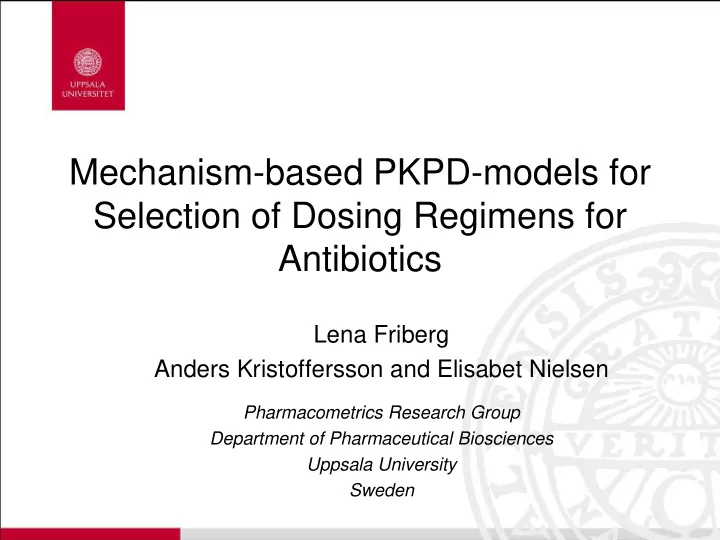

Mechanism-based PKPD-models for Selection of Dosing Regimens for Antibiotics Lena Friberg Anders Kristoffersson and Elisabet Nielsen Pharmacometrics Research Group Department of Pharmaceutical Biosciences Uppsala University Sweden
Selection of dosing regimens for antibiotics Traditional way 1. Determine Type and Target magnitude of PK/PD index – f AUC/MIC, f T>MIC or f C max /MIC typically identified in mice (bacterial kill at 24h) 2. Find regimen that results in acceptable Probability of Target Attainment (PTA) – Simulations from a Population PK model, MIC (distribution) and the defined Target magnitude Assumptions: Same target independent of patient population Ex. Meropenem dosed according to 40% f T>MIC (Drusano et al. Clin Infect Dis, 2003) Difficulties: Summary variables cannot handle complexities such as – Drug combinations – Resistance development Evolving way PKPD-modelling of data from in vitro time-kill experiments and in vivo data → Time-courses
Mechanism-based PKPD-models for Antibiotics Static • In vitro time-kill concentrations curve data Dynamic concentrations • Model structure includes – Natural bacterial growth – Drug effect – Resistance mechanism Ex. Model structure for gentamicin and colistin Mohamed et al., AAC 2012, Mohamed et al., JAC 2014
Prediction of PK/PD indices Simulate mouse study on meropenem (Katsube et al., J Pharm Sci, 2008) 3 x 4 dosing regimens (4 dosing intervals, Model based on 3 dose levels) in vitro data PK: t 1/2 ~ 0.3 h f C max /MIC, f AUC/MIC and f T>MIC Log 10 CFU/ml at 24h
Simulation PK/PD indices - Meropenem Mouse PK Mouse: t 1/2 ~ 0.3 h (Katsube et al., J Pharm Sci, 2008) f AUC/MIC f T>MIC f C max /MIC • f T>MIC best PK/PD index as typically reported for carbapenems (and other β -lactams) • Target of 40% f T>MIC recommended for meropenem (Drusano et al., Clin Infect Dis, 2003)
Prediction of PK/PD indices Colistin in mice Observed data in mice 3 log kill: 35 (Dudhani et al., AAC 2010) Predictions from same PK and a mechanism- 3 log kill: 12 based PKPD-model for colistin (Mohamed et al., JAC, 2014) Khan et al., In manuscript
Vancomycin Moxifloxacin Gentamicin Erythromycin Cefuroxime Penicillin PKPD-models based on in vitro data can predict PK/PD-driver determined in vivo Nielsen et al., AAC 2011
Simulation PK/PD indices - Meropenem Typical adult patient PK Typical: Adult, CrCL=83 ml/min 2-comp PK, t 1/2, β ~ 1 h (Li et al. , J Clin Pharmacol, 2006) f AUC/MIC f T>MIC f C max /MIC • 32% f T>MIC for 2-log kill is close to the commonly cited value of 40% (Drusano et al., Clin Infect Dis, 2003) • f AUC/MIC is nearly as good predictor as f T>MIC
Simulation PK/PD indices - Meropenem Different patient populations Typical: Adult, CrCL=83 ml/min 2-comp PK, t 1/2, β ~ 1 h (Li et al , J Clin Pharmacol 2006) Selection of ’best’ PK/PD-index is sensitive to Renal dysfunction: Adult, CrCL=15 ml/min PK in the population 2-comp PK, t 1/2, β ~ 1.5 h (Li et al , J Clin Pharmacol 2006) Preterm neonate: GA 31w 2-comp PK, t 1/2, β ~ 1.5 h (van den Anker et al , AAC 2009) f AUC/MIC f T>MIC f C max /MIC • Best predictor moves towards f AUC/MIC for increased half-lives • f T>MIC indicates a higher target (exposure should be increased ) • f AUC/MIC indicates a lower target (exposure can be decreased )
Probability of Target Attainment (PTA) Different dosing regimens of meropenem Typical CL Renal Dysfunction Augmented CL 2 mg, 1h inf q8h Probability of Target Attainment Choice of PK/PD-driver and 2 mg, 3h inf target will affect treatment q8h decisions for different MICs 6 mg / 24h cont. inf • f T/MIC predicts higher PTA at a specific MIC level
Value of continuous meropenem infusion in different patient populations? Typical CL Renal Dysfunction Augmented CL 2 mg, 1h inf q8h 2 mg, 3h inf q8h 6 mg / 24h cont. inf
Conclusions • Mechanism-based PKPD-models based on in vitro data can predict in vivo PKPD results • Typically assumed to be one ´ true ´ PK/PD index and target magnitude, but they are sensitive to – PK in the population – MIC value – Resistance development – Design
Potential uses of a mechanism-based PKPD-model based on in vitro data • Improved designs of animal experiments – Ethical and financial benefits • An understanding of the time-course of drug effects – Influence of resistance development – Predictions beyond experimental time? • A range of dosing scenarios can be explored – Dosing regimens – Loading dose – Drug combinations • Correlations between MIC and EC 50 – Limited data needed to explore time-courses for new mutants (Khan et al., Submitted )
Thank you!
Recommend
More recommend